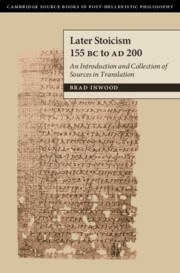87 results
3 - Oikeiōsis and the Origin of Virtue
- from Part II - The Role of Virtue
-
-
- Book:
- Cicero's ‘De Officiis'
- Published online:
- 15 June 2023
- Print publication:
- 29 June 2023, pp 63-77
-
- Chapter
- Export citation
Dedication
-
- Book:
- Later Stoicism 155 BC to AD 200
- Published online:
- 30 April 2022
- Print publication:
- 19 May 2022, pp v-vi
-
- Chapter
- Export citation
Chapter 3 - From Posidonius to Seneca
-
- Book:
- Later Stoicism 155 BC to AD 200
- Published online:
- 30 April 2022
- Print publication:
- 19 May 2022, pp 154-206
-
- Chapter
- Export citation
Index of Sources
-
- Book:
- Later Stoicism 155 BC to AD 200
- Published online:
- 30 April 2022
- Print publication:
- 19 May 2022, pp 564-568
-
- Chapter
- Export citation
Chapter 6 - The Second Century ce
-
- Book:
- Later Stoicism 155 BC to AD 200
- Published online:
- 30 April 2022
- Print publication:
- 19 May 2022, pp 444-551
-
- Chapter
- Export citation
Abbreviations
-
- Book:
- Later Stoicism 155 BC to AD 200
- Published online:
- 30 April 2022
- Print publication:
- 19 May 2022, pp xii-xii
-
- Chapter
- Export citation
Chapter 1 - The First Hundred Years
-
- Book:
- Later Stoicism 155 BC to AD 200
- Published online:
- 30 April 2022
- Print publication:
- 19 May 2022, pp 6-83
-
- Chapter
- Export citation
Introduction
-
- Book:
- Later Stoicism 155 BC to AD 200
- Published online:
- 30 April 2022
- Print publication:
- 19 May 2022, pp 1-5
-
- Chapter
- Export citation
Copyright page
-
- Book:
- Later Stoicism 155 BC to AD 200
- Published online:
- 30 April 2022
- Print publication:
- 19 May 2022, pp iv-iv
-
- Chapter
- Export citation
Bibliography
-
- Book:
- Later Stoicism 155 BC to AD 200
- Published online:
- 30 April 2022
- Print publication:
- 19 May 2022, pp 557-563
-
- Chapter
- Export citation
Concordance
-
- Book:
- Later Stoicism 155 BC to AD 200
- Published online:
- 30 April 2022
- Print publication:
- 19 May 2022, pp 552-556
-
- Chapter
- Export citation
Contents
-
- Book:
- Later Stoicism 155 BC to AD 200
- Published online:
- 30 April 2022
- Print publication:
- 19 May 2022, pp vii-x
-
- Chapter
- Export citation
General Index
-
- Book:
- Later Stoicism 155 BC to AD 200
- Published online:
- 30 April 2022
- Print publication:
- 19 May 2022, pp 569-584
-
- Chapter
- Export citation
Chapter 4 - Seneca the Younger
-
- Book:
- Later Stoicism 155 BC to AD 200
- Published online:
- 30 April 2022
- Print publication:
- 19 May 2022, pp 207-342
-
- Chapter
- Export citation
Chapter 2 - Posidonius
-
- Book:
- Later Stoicism 155 BC to AD 200
- Published online:
- 30 April 2022
- Print publication:
- 19 May 2022, pp 84-153
-
- Chapter
- Export citation
Chapter 5 - Epictetus
-
- Book:
- Later Stoicism 155 BC to AD 200
- Published online:
- 30 April 2022
- Print publication:
- 19 May 2022, pp 343-443
-
- Chapter
- Export citation
Acknowledgements
-
- Book:
- Later Stoicism 155 BC to AD 200
- Published online:
- 30 April 2022
- Print publication:
- 19 May 2022, pp xi-xi
-
- Chapter
- Export citation

Later Stoicism 155 BC to AD 200
- An Introduction and Collection of Sources in Translation
-
- Published online:
- 30 April 2022
- Print publication:
- 19 May 2022
Bibliography
-
- Book:
- Body and Soul in Hellenistic Philosophy
- Published online:
- 20 May 2020
- Print publication:
- 11 June 2020, pp 231-251
-
- Chapter
- Export citation
Copyright page
-
- Book:
- Body and Soul in Hellenistic Philosophy
- Published online:
- 20 May 2020
- Print publication:
- 11 June 2020, pp iv-iv
-
- Chapter
- Export citation



